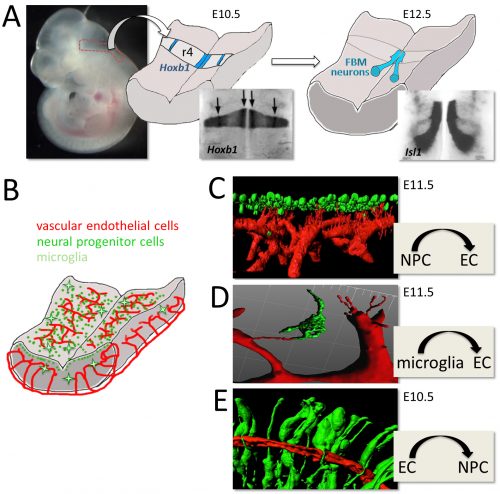Christiana Ruhrberg, winner of the BSDB Cheryll Tickle Medal 2018
Posted by BSDB, on 24 October 2017

 Christiana Ruhrberg studied Biology at the Justus Liebig University (Giessen, Germany), and obtained her first class Diploma/MSc degree in 1992. After taking on an MSc/research assistant position at the University of Sussex for two years to elucidate genetic changes in ovarian cancer, she moved to Imperial College London to work for another two years to study the genomic organisation of the gene-rich human ‘surfeit’ locus. She then carried out her PhD project in the laboratory of Fiona Watt at the Imperial Cancer Research Fund (1994-97) where she identified and described the function of the envoplakin and periplakin genes. Her postdoctoral research in the laboratories of Robb Krumlauf at the National Institute for Medical Research in London (1997-1999) was funded by a MRC postdoctoral training fellowship and dedicated to studying the role of Hoxa1, Hoxb1 and Hoxb2 during hindbrain development. During her second postdoc with David Shima at the Imperial Cancer Research Fund in London (2000-2002), she was funded by a ICRF fellowship and worked on VEGF-A-mediated blood vessel branching. Having received an MRC Career Development Award in 2003, she became an independent investigator at University College London’s Institute of Ophthalmology studying links between vascular and neuronal development, with particular focus on the roles of VEGF and SEMA3A signalling during facial nerve and blood vessel formation. Staying at that same institute, she was appointed Lecturer in 2007, promoted to Reader in 2008 and then full Professor in 2011. Christiana has an excellent record in obtaining research funding, as illustrated by a Wellcome Trust Junior Investigator Award in 2011 and a Wellcome Trust Investigator Award in 2016 for her research on vascular biology and neurovascular interactions.
Christiana Ruhrberg studied Biology at the Justus Liebig University (Giessen, Germany), and obtained her first class Diploma/MSc degree in 1992. After taking on an MSc/research assistant position at the University of Sussex for two years to elucidate genetic changes in ovarian cancer, she moved to Imperial College London to work for another two years to study the genomic organisation of the gene-rich human ‘surfeit’ locus. She then carried out her PhD project in the laboratory of Fiona Watt at the Imperial Cancer Research Fund (1994-97) where she identified and described the function of the envoplakin and periplakin genes. Her postdoctoral research in the laboratories of Robb Krumlauf at the National Institute for Medical Research in London (1997-1999) was funded by a MRC postdoctoral training fellowship and dedicated to studying the role of Hoxa1, Hoxb1 and Hoxb2 during hindbrain development. During her second postdoc with David Shima at the Imperial Cancer Research Fund in London (2000-2002), she was funded by a ICRF fellowship and worked on VEGF-A-mediated blood vessel branching. Having received an MRC Career Development Award in 2003, she became an independent investigator at University College London’s Institute of Ophthalmology studying links between vascular and neuronal development, with particular focus on the roles of VEGF and SEMA3A signalling during facial nerve and blood vessel formation. Staying at that same institute, she was appointed Lecturer in 2007, promoted to Reader in 2008 and then full Professor in 2011. Christiana has an excellent record in obtaining research funding, as illustrated by a Wellcome Trust Junior Investigator Award in 2011 and a Wellcome Trust Investigator Award in 2016 for her research on vascular biology and neurovascular interactions.

Figure: Using the mouse embryo hindbrain to elucidate neuronal and vascular development. (A) The hindbrain from an embryonic day (E) 10.5 mouse was dissected to perform visualise the expression of Hoxb1 in rhombomere 4 (A), the origin of the Isl1-positive facial branchiomotor (FBM) neurons, which can be observed during their caudal migration by Isl1 at E12.5 (B). (B-F) Main cell types (B) and cell interactions (C-F) in the developing mouse hindbrain. In (C-F), dissected hindbrains were stained with the vascular endothelial marker IB4 (red) and markers for mitotic neural progenitors, microglia or neural progenitor processes, shown in green in C-E, respectively). Note that neural progenitors attract sprouting blood vessels (C), the physical contact between microglial and endothelial processes (D) and that neural progenitor processes contact vasculature (E).
Christiana has been a mentor to 11 PhD students and 6 postdocs, 3 of whom have now established themselves as independent investigators. She has published many influential papers in the fields of vascular, neuronal and neural crest cell development, including primary research articles and reviews, methods papers and book chapters. Twelve of her research papers have been listed as recommended reads by the Faculty of 1000, five have been featured with cover images and six have been featured in editorials in influential journals such as JCB, PNAS, Nature, Science, Neuron and JCI.
Christiana received an impressive amount of honours, including the title ‘Young Cell Biologist of the Year’ (BSCB, 1996), the ‘Werner-Risau-Prize’ (German Society for Cell Biology, 2003), the MRC’s ‘Science Heirloom’ (Suffrage Science, 2011). She was also named an ‘Academic Role Model’ (UCL, 2013) and is listed in EMBO’s ‘Expert Women in Life Sciences’ (2013) and ‘AcademiaNet’ (Robert Bosch Stiftung, Germany, 2014). Besides all these achievements, Christiana takes on regular institutional responsibilities, is a member of various grant committees and a contributing member of the Faculty 1000, editor for PLoS One, and serves on programme committees of a number of scientific meetings.
The BSDB makes it a tradition to ask the Cheryll Tickle Medal awardees a number of questions concerning our field and its future. Please, read Christiana’s answers below.
What were the questions that inspired you to work in the field of Developmental Biology?
I was initially attracted to working in the field of developmental biology when the first mouse knockouts became available. Many of them had lethal phenotypes, making embryological studies imperative to determine the physiological functions of the ablated genes. I initially examined mouse knockout models to identify molecules that regulate the migration of facial branchiomotor neurons and subsequently to determine how the growth factor VEGF orchestrates blood vessel morphogenesis. By answering two different biological questions with the mouse embryo hindbrain as a model system, I serendipitously identified VEGF as the elusive migratory cue for facial branchiomotor neurons. This finding inspired me to continue investigating VEGF functions in neuronal and vascular development, with a more recent strive to apply knowledge gained through developmental studies also to further our understanding of disease processes in the adult.
Why should young researchers continue to engage in Developmental Biology?
Personally, I have always been fascinated by how the vertebrate body develops to enable postnatal life. Developmental studies also yield striking images of a multitude of diverse cellular processes that coordinate organ morphogenesis, making this type of research not only exciting, but also aesthetically pleasing. The PhD students, postdocs and technicians who train in my laboratory share these sentiments and have gained much deserved appreciation for their developmental biology research work through journal cover images and when winning presentation prizes at conferences. Developmental biology research also impacts on public health, because understanding how embryonic processes yield functional organs informs regenerative medicine. In particular, knowing how functional tissues are built normally might one day soon provide a gold standard for designing therapeutic strategies to recreate or repair dysfunctional tissues. That said, the developmental biology community is increasingly faced with the challenge of having to convince funding agencies that developmental biology research can underpin research into tissue repair and regeneration!
Which were the key events or experiences in your life that influenced your career decisions and paved your path to success?
My career path has not been straightforward, but encompassed a series of obstacles and opportunities. For example, the failure to appoint a successor for our retiring genetics professor at my home university in Germany could have persuaded me to switch subjects from molecular biology and genetics to a different one to avoid a significant delay to graduation, but I took this challenge as an opportunity to study for a year in the UK, being the first student on my course to embark on such an overseas placement. I ended up staying at the University of Sussex for almost 2 years to complete a research project all the way to publication, returning to Germany only to submit my thesis. Incredibly, after all the long hard work, I almost did not graduate, because those in charge at my German University deemed an English-written thesis unacceptable! This experience encouraged me to return to the UK to continue academic research in an English-speaking environment. Unfortunately, I initially chose a PhD supervisor at the Imperial Cancer Research Fund who turned out to be rather unsupportive of my endeavours; yet, I was able to make a ‘lateral’ move within the same organisation to re-start my PhD with Fiona Watt. She was a most inspirational PhD supervisor and mentor, and later matched me with an ideal postdoc supervisor in Robb Krumlauf at the National Institute of Medical Research. In Robb’s lab, I discovered both my love for developmental biology and the inspirational community of scientists working in this area. In a nutshell, it was not careful planning that allowed me to get to my current career stage, but my unwavering enthusiasm for research combined with resilience when faced with adversity and the will to take advice and encouragement from my fabulous mentors Fiona and Robb.
What advice do you give young researchers towards a successful career?
Whether you choose to continue on an academic career or embark on an alternative career, I recommend everyone to take advantage of transferable skills training to complement the technical training gained in the research environment. Strengthening your verbal and written communication skills, learning about project and team management and developing effective networking skills will provide a strong foundation to equip you for success in a diverse range of career options.


 (2 votes)
(2 votes)